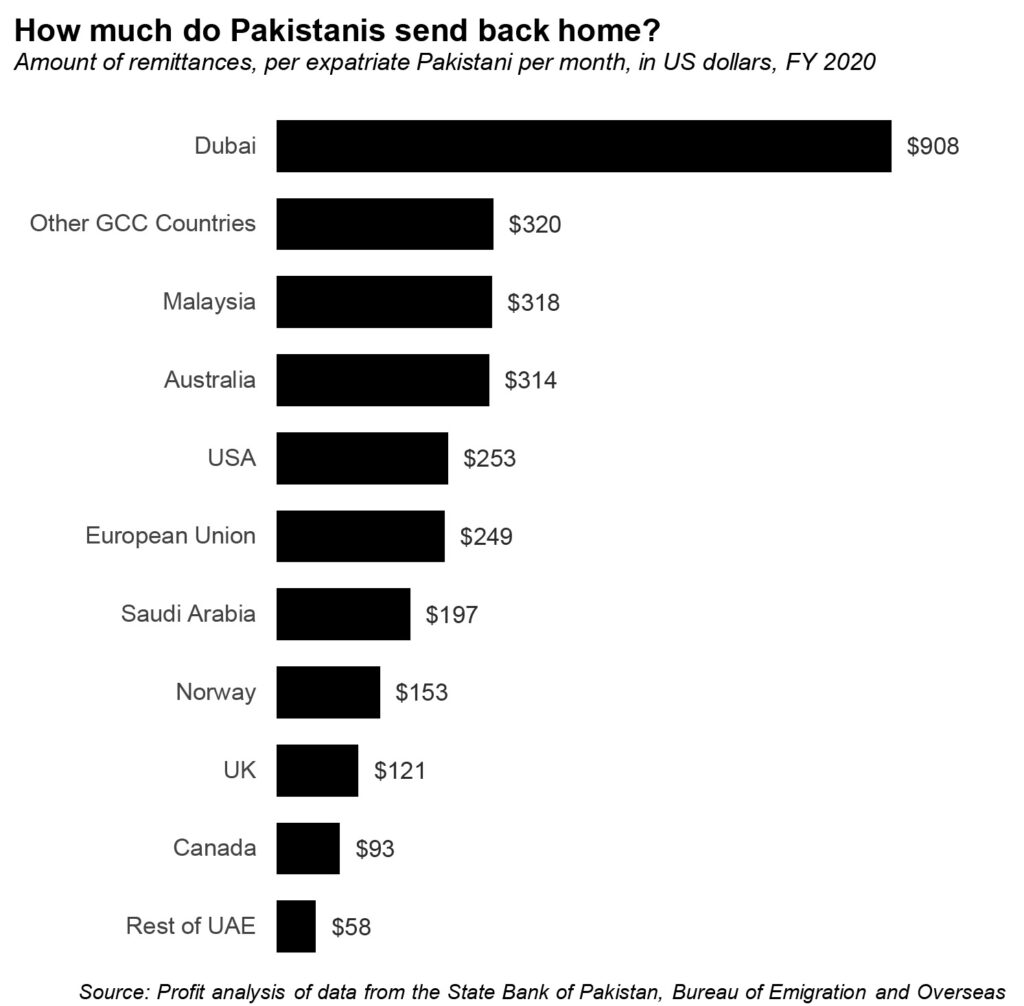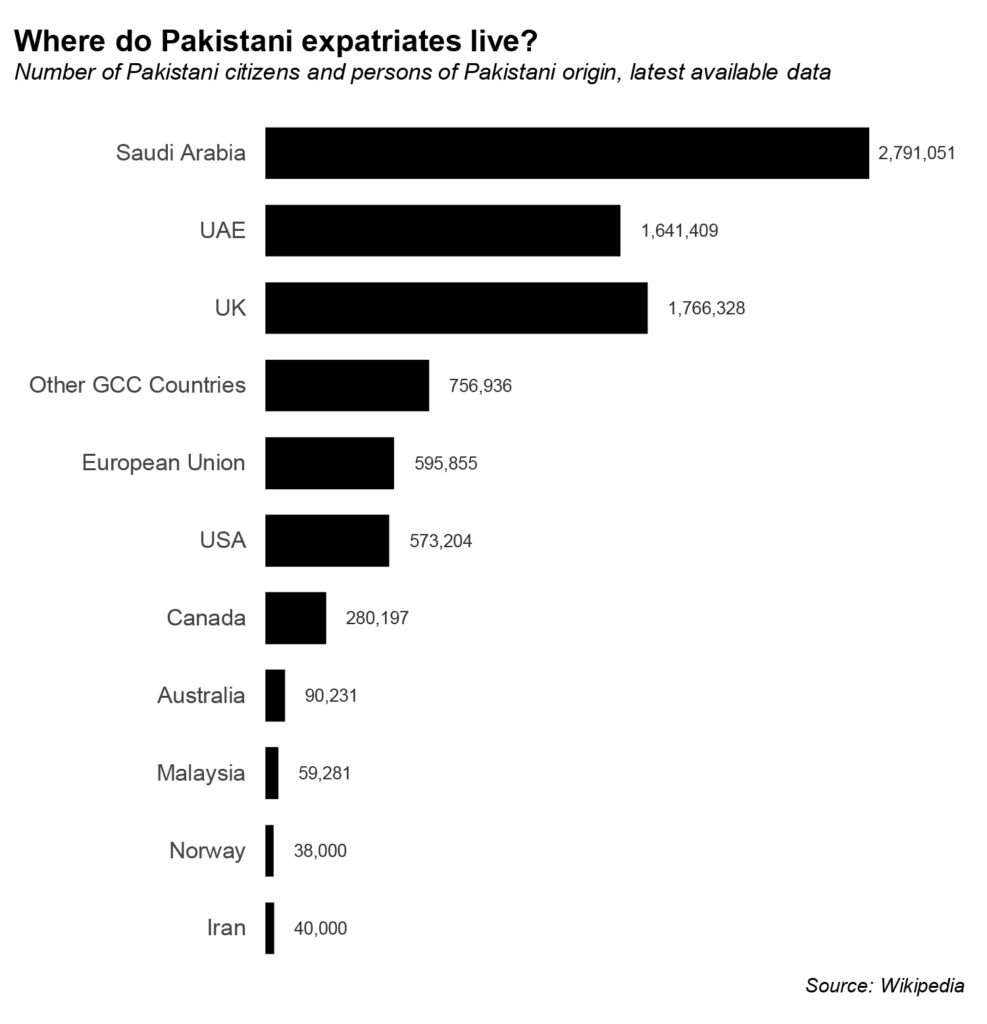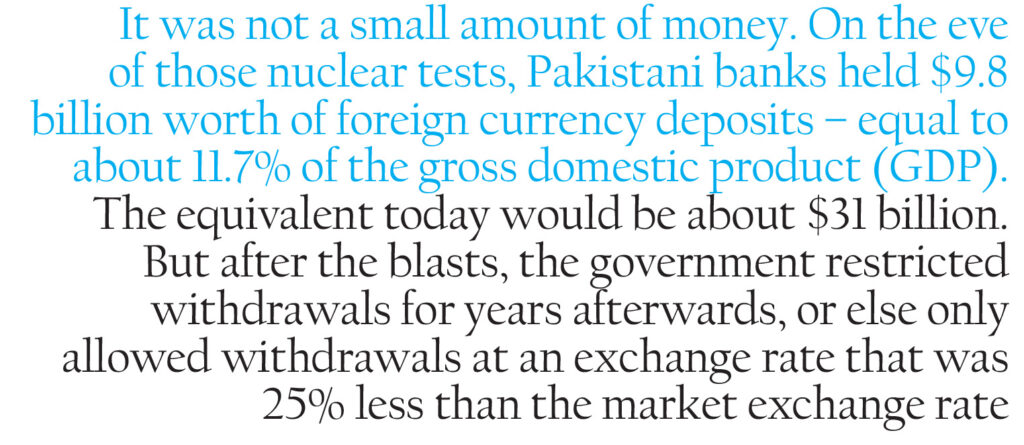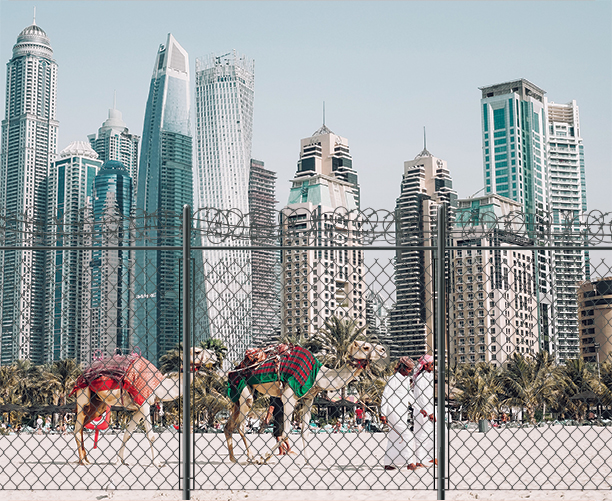There is an idea that has been doing the rounds in Washington DC over the past year and a half – in the very small circle of people who still care about relations between Pakistan and the United States – that if the United States ever wanted to get serious about forcing Pakistan to change its policies to what the US wanted, all it needed to do was to get the government of the United Arab Emirates to stop issuing visas to Pakistan’s elite.
It appears that someone at the UAE government had the same idea, because after a diplomatic flare-up – the precise causes of which remain unclear – the government of the UAE has announced that it will no longer be issuing visas to the citizens of several countries, including Pakistan.
Pakistanis still living in the UAE will be eligible for renewal of their visas, but no new visas will be issued to anyone outside the UAE, and if a Pakistani in the UAE loses their eligibility for a visa (say, they lose their job), they will immediately need to leave the country. Pakistan appears to be the only country for which the ban extends to work visas in addition to visit visas.
The UAE government has not stated why this policy has been put in place, and public statements from officials at the Foreign Office in Islamabad suggest that the government of Pakistan has not even been informed in private as to why the UAE has effectively banned the entry of Pakistanis into their country.
It is not the domain of this publication to analyse the country’s foreign policy, or to advise the government on how to conduct it, but Pakistan’s relations with the UAE have a very large economic component, and hence it is relevant to a discussion of the Pakistani economy to understand how a rift between Islamabad and Abu Dhabi might play out.
Here is what it all boils down to: the UAE is the second largest source of remittances to Pakistan, only slightly behind Saudi Arabia (which has an expatriate Pakistani population nearly twice the size of the UAE), and nearly as much as the remittances from the United States, Canada, and the European Union combined. It is also our second-largest trading partner, behind only China, and the single largest source of Pakistan’s oil imports.
But it is the remittances data that is particularly interesting because the remittances from the UAE are too high to be justified by the Pakistani expatriate population alone. We contend that much of the money being technically ‘remitted’ from the UAE was in fact money earned in Pakistan and just moved to the UAE for safekeeping, and simply making its way back to Pakistan for reinvestment.
Of course, everyone knows that Pakistanis – particularly the upper middle class and the wealthy elite – like to park money in the UAE. But Profit has conducted an analysis that has, to a degree, been able to quantify at least the part of that capital that flows back towards Pakistan.

More to the point, however, it means that Pakistanis are more dependent on the UAE than just the trade and remittances data alone would suggest. There is Pakistani wealth currently invested and parked in the UAE that would get trapped there if this diplomatic tussle were to last too long.
But it also represents an opportunity for Pakistanis – and especially the government of Pakistan – to re-examine the role of the UAE as that financial safe haven. As we will examine later in this story, the UAE’s position as the bolt hole for wealthy Pakistanis is more vulnerable than it looks. There is no reason the money parked in Dubai cannot stay in Karachi, Lahore, Faisalabad, etc.
In short, this crisis represents an interesting inflection point: if we collectively break our Dubai addiction, we may well be able to increase the amount of capital available for the investment needed to grow Pakistan’s economy faster.
But first: a quick recap of how we got into this mess in the first place.
Trying to play neutral in the Second Arab Cold War
It has been obvious for some time now that there is a bloc of five of the six members of the Gulf Cooperation Council (GCC), led by Saudi Arabia and the UAE, that have been engaged in a contest for domination over the Levant (the old Bilad Al-Shaam, the region now comprising Syria, Lebanon, Jordan, Palestine, Israel, and Iraq) against first just Iran and now also Turkey. This context is not restricted to just the Levant and is also the reason for the war in Yemen.
We will not delve into the historical reasons and the geopolitical complexities of this second Cold War involving the Arab World that has occasionally turned hot. The author of this story simply does not have the expertise to speak with any degree of confidence on this matter.
What is relevant to this story (and what we will comment on) is the Pakistani reaction to all of this. In the first Arab Cold War (1952 through 1979), Pakistan was firmly on the side led by the Saudis and against the Arab nationalists first led by former Egyptian President Gamal Nasser. A bedrock principal of Pakistani foreign policy has been the alliance with Saudi Arabia and (since its independence in 1971) the UAE, both of which have almost invariably been allied to each other.


Indeed, Pakistan was so completely in Saudi Arabia’s corner that, when Saudi Arabia became a participant in the Arab Israeli conflict in the early 1970s, Pakistan lent military assistance to the Arab side of the 1973 Arab Israeli war, and two Pakistan Air Force pilots were shot down in dog fight over the Golan Heights in Syria. And when the Palestinian Liberation Organisation (PLO) became a nuisance for the government of Jordan in September 1970, it was Pakistan Army troops led by then-Brigadier Zia-ul-Haq who helped the Jordanian government to quell the Palestinian uprising.
This kind of unflinching military support from Pakistan is something that the Arab governments came to expect, and repaid in kind when Pakistan needed economic support. In 1998, as the United States and Europe imposed sanction on Pakistan for conducting a series of nuclear tests, Saudi Arabia and the UAE lent Pakistan $500 million each in oil on deferred payments, and also helped shore up Pakistan’s foreign exchange reserves.
When it was simply actions outside of Pakistan, Islamabad had no problem working with the Saudi-led alliance, particularly when it meant that the Saudis and Emiratis would be paying for Pakistan’s efforts. But then, after the Iranian Revolution in 1979, things started to get messy and the Arab Cold War became the Arab-Iranian Cold War which would occasionally get hot within Pakistan, with pro-Saudi and pro-Iranian militants killing each other and innocent Pakistani bystanders in Pakistani streets.
By 2008, the incoming Zardari Administration decided to adopt a major change in Pakistani foreign policy, and one that was backed by the military leadership: while Pakistan would remain a Saudi ally, it would adopt a strict policy of neutrality in the new Cold War between the Saudi-led alliance and the Iran-led alliance.
The Saudis and Emiratis were not particularly thrilled about Pakistani neutrality, but at the time, Pakistan was not asking them for any favours, knowing full well that those favours would come with a price tag. The Nawaz Administration, which came into office in 2013, however, blundered in not following that script.
In 2014, they asked for – and received – economic assistance from both Saudi Arabia and the UAE totaling $3 billion to help shore up Pakistan’s foreign exchange reserves. The next year, when Saudi Arabia went to war against an Iranian-backed militia in Yemen, it expected Pakistani troops to participate on their behalf. But Parliament refused to allow Pakistani troops to go off and die in someone else’s war. And therein lay the roots of Pakistan’s major foreign policy blunder.
Pakistan had now taken Saudi and Emirati money just like when it was a firm ally of theirs, but when it came time to repay the favour through military support, the government suddenly remembered the new neutrality policy. Pakistan then doubled down on snubbing those two governments by joining Turkey and Iran in aiding Qatar with food supplies during the ongoing blockade by the Saudi-led alliance that began in 2017.
That was never going to go over very well in Riyadh or Abu Dhabi, and it was only a matter of time before something would push them over the edge to exact retribution on Pakistan. It is not exactly clear what miffed the UAE this time – perhaps it was Prime Minister Imran Khan publicly complaining, without naming names but dropping heavy hints, that Islamabad was being pressured to establish diplomatic ties with Israel – but regardless, they have now done it, which means that Pakistanis need to get used to the idea that the UAE is no longer as safe a place for Pakistanis in terms of access as it once was.
Not just expatriate money
This has far-reaching consequences for Pakistan’s economy. Pakistanis have long relied on the UAE as the favoured safe haven to park assets outside the country, both as a hedge against political instability inside Pakistan as well as a place where they can circumvent Pakistan’s capital control laws. That reliance on the UAE rested on an implicit assumption: that if you were an upper middle class or wealthy Pakistani, you would always be able to travel to Dubai on a moment’s notice, even on a Pakistani passport.
That impression was helped by the fact that – for most of the past four decades – that has been true. Indeed, it is so true, that (before the pandemic) there were more flights per week between Karachi and Dubai than there are between Karachi and Lahore, and getting a UAE e-visa was progressively getting easier. Essentially, if you could afford the Emirates or Etihad ticket, you would be allowed access to Dubai and Abu Dhabi.
That ease of access, coupled with UAE’s favourable laws that made it easy to incorporate businesses and move money out of Pakistan in the guise of exports and then back in the guise of remittances (more on how that works below) made the UAE the destination of choice for Pakistani money looking for an escape hatch.
Here is how this works: a Pakistani business that has an export operation will export goods from Pakistan, but will under-declare the amount being sold by the Pakistani legal entity, and instead book part of the revenue through a UAE-registered company. When they get paid by their buyers, part of the money will come back to Pakistan, and part of it will remain in the UAE.

Banks involved in trade finance in Pakistan know of this arrangement and tolerate the under-declaration because they know the letters of credit they issue will get repaid either in Pakistan or in the UAE, so they do not care where the money is declared.
This arrangement is incorrectly reported in the Pakistanis press as a crime. It is not, in the strictest sense, illegal, though it comes very close to violating some rules and interpretations of the State Bank of Pakistan’s Foreign Exchange Manual.
It is also not hiding ill-gotten wealth, or evading taxes. The money being funneled out of the country is by legitimate exporters, and export earnings are taxed at a very low 1% of revenues, and every wealthy person in Pakistan who could have declared wealth in Pakistan with that low a rate of taxation would prefer to have it that way. So why do they do it?
It goes back to 1998, when, in the aftermath of the May 1998 nuclear tests, the government overnight reversed its policy on allowing Pakistanis to maintain foreign currency deposits in Pakistani banks and deploy them with ease wherever they wished. In those days, many wealthy Pakistanis still held assets overseas, but a large proportion of them – particularly those who were not rich but merely upper middle class – used to hold dollar deposits in Pakistani banks because those deposits allowed them a hedge against the decline of the Pakistani rupee, as well as the ability to move money abroad as and when they needed (with some restrictions).
It was not a small amount of money. On the eve of those nuclear tests, Pakistani banks held $9.8 billion worth of foreign currency deposits – equal to about 11.7% of the gross domestic product (GDP). The equivalent today would be about $31 billion. But after the blasts, the government restricted withdrawals for years afterwards, or else only allowed withdrawals at an exchange rate that was 25% less than the market exchange rate.
It caused an utter collapse in confidence in those bank accounts. By 2003, when those restrictions were finally completely lifted, dollar deposits in Pakistani banks collapsed to just $293 million, a steep 97% decline from the 1997 peak of $9,843 million.
Where did all of that money go? Many places, but a lot of it went to Dubai, along with the money earned after that period that those wealthy people still wanted away from the reach of the government of Pakistan.
While it is difficult to say exactly how much Pakistani money went to the UAE, we do have estimates of how much money comes back each year. At some level, the State Bank of Pakistan knows that Pakistanis park their money in Dubai and the money coming back as ‘remittances’ are not really earnings of expatriates but money that is simply being recycled as such by resident Pakistanis earning money inside Pakistan.
That is why the State Bank breaks out remittances from the UAE by emirate, a level of detail it does not offer for any other country, including Saudi Arabia, which has consistently been the largest source of remittances for Pakistan.

That breakdown of the data between Dubai and other Emirates reveals some startling patterns: Pakistanis in the UAE seem to send a lot more money than any other category of expatriates, at levels that are simply not justifiable through data on the number of expatriates living there alone would suggest.
In the financial year ending June 30, 2020 – most of which was unaffected by the coronavirus pandemic – Pakistanis based in the UAE sent $5,612 million in remittances back. Within that, about $4,768 million supposedly came from the approximately 438,000 Pakistanis who live in Dubai, and just $844 million came from the 1.2 million Pakistanis living in the other emirates.
That implies that a Pakistani living in Dubai sent $908 per month, which seems like an astoundingly high number. The corresponding number for the other emirates is just $58 per month, which is more in line with what one might expect to find. Even Pakistani expats in Saudi Arabia, with its much lower cost of living, are only able to send back an average of $197 per expat per month.
To clarify, when we say ‘per expatriate’, we are including in our count the dependents of every earning person living abroad. A Pakistani family in Dubai consisting of a couple and their three children, in our calculations, counted as five people, even if only one person in that household is earning. Our calculations for the number of Pakistani expatriates in each country rely on estimates from each government as well as the government of Pakistan’s Bureau of Emigration and Overseas Employment.
If we ‘normalise’ the remittance levels from Dubai to those from the rest of the UAE, we arrive at an astonishing estimate: about $307 million of the $4,768 million – just 6.4% of the total – in ‘remittances’ from Dubai probably come from Pakistanis actually living and working in Dubai. The remaining $4,461 million is likely money being recycled by people who earned that money inside Pakistan and had parked it there for safe-keeping.
That money is coming back to Pakistan to be spent on things like family weddings, or to buy a house, or even to invest in businesses within Pakistan. For context, the total amount of foreign direct investment in Pakistan in fiscal year 2020 was $2,038 million, or less than half the amount of money recycled from Dubai.
Needless to say, that implies that there is several billion dollars worth of Pakistani assets parked in Dubai, either in that city’s residential real estate market, or in financial institutions based there. All of that money went there under the assumption that it would be safely accessible. Now, even if these visa restrictions are eventually lifted – as the government of Pakistan’s restrictions on foreign currency accounts eventually were – how many Pakistanis will feel safe keeping that money in the UAE?
It is very likely that Pakistani money will start exiting Dubai, no matter what happens next in the visa saga. Once confidence is shaken, it is very, very hard to earn it back. So where will the money go next?
If you love the money, set it free
Singapore, with its focus on becoming the asset management hub of Asia, is the likeliest candidate for where that money could end up, with London also another possibility. New York – with its aversion to Pakistani money in wake of the country’s Financial Action Task Force (FATF) worries – is unlikely to see much of it, and Zurich only wants the filthy rich, so the merely well-off will not be welcome there.
But while the Foreign Office must be dealing with how to minimize the diplomatic fallout of the UAE visa ban, the Finance Ministry needs to become obsessed with how to ensure that instead of going to Singapore or London, that Pakistani money in Dubai comes back home to Karachi, Lahore, Faisalabad, Multan, Gujranwala, etc.

And in order to do that, the government must understand why it left in the first place. Pakistanis who live inside Pakistan want the safety of knowing that they can leave with their money if they ever need to. It is a paranoia born out of a rational fear of nationalization and other forms of expropriation that have taken place before in Pakistani history, most notably in the 1970s nationalization drive by the Bhutto Administration, but also in 1998 by the foreign currency account freezing by the Nawaz Administration.
If the government of Pakistan is to coax Pakistani money parked abroad back into the country, it needs to do so by tying its own hands and outlawing permanently the ability of the government to seize the assets of any Pakistani citizen without due process in a court of law, and it must also outlaw permanently the ability of the government to restrict the ability of Pakistani citizens to move their legitimately earned and taxed wealth in and out of the country as they please.
The only way to do so would be through an Act of Parliament that enshrines these rules, and prohibits the Finance Ministry from issuing any Statutory Regulatory Orders (SROs) that contravene that law. Doing so would send a clear signal: the government of Pakistan has created a rule that it is binding itself to, and one that cannot be changed overnight, and instead will require active and public debate in Parliament if ever there came a need to change it.
By increasing the costs to itself of changing the rule, it would convince Pakistanis who currently keep their money outside the country “just in case” to keep that same money inside the country in foreign currency deposits. That, in turn, would have significant stabilizing effects on the economy.
Imagine if private banks in Pakistan had the same level of foreign currency deposits relative to GDP that they did back in 1997: about $31 billion? How much more money would be available to Pakistani businesses to borrow from domestic banks, and how much more the government could rely on domestic financing without having to turn overseas?
To do so, however, will be an extraordinary act of faith on the part of the government that – over time – Pakistani citizens will come to trust their government again. But it is an act of faith that the government needs to undertake. It is not often that a government gets a second chance to win back the trust of its citizens who have been burned before. It may not come again. The time to seize it is now.


























I hate paywalls.
WE must work on improving relations with our Muslim brothers and sisters. We have to realise that it is in the interests of our enemies that we fight amongst ourselves.
UAE doesn’t care about Muslim unity, so that’s an impossible task. They care about money, not morality. They both poor Yemenis without any second thought. They embrace Israel and Modi. They act progressive, yet will put any Emirati in prison who dares to criticize the government.
They bomb Yemenis*
Now profit walls also going to b paid content..bad decision
Pakistan is passing through a transition.So are the Arab countries of ME.Our foreign policy supports UAE and S’Arabia dearly. Recognition of Israel by these countries is a big question mark these days.UAE leading, has earned a bad name amongst all Muslims who support Palestinean cause since 1948. Pakistan so far is holding on to its policy of supporting Palestine against Israel. That may be the cause of UAE reaction. We should continue to follow our close relations with UAE. A step against it will not only harm Muslim unity in general, but also our our own economic interests. Although public sentiment in Pakistan has turned against UAE.
UAE is trying to bully Pakistan. It’s obvious. They’re upset we didn’t join their disastrous Yemen war, that we didn’t cut off ties with Qatar, and that we are still friendly to Iran and Turkey. They got lucky that they struck oil, and now are trying to act like the dictator of the Muslim world. After the Iran deal is resumed under Biden, we should have no qualms to strengthen ties with Iran, and build the Iran-Pakistan gas pipeline. We should not be bullied by a small country that bought influence with oil money.
No Pakistani pilots were shot down over the Golan, it was actually an Israeli pilot that was shot down. Where did you get your info from? The lajna help desk at the qadiani temple in occupied Haifa?